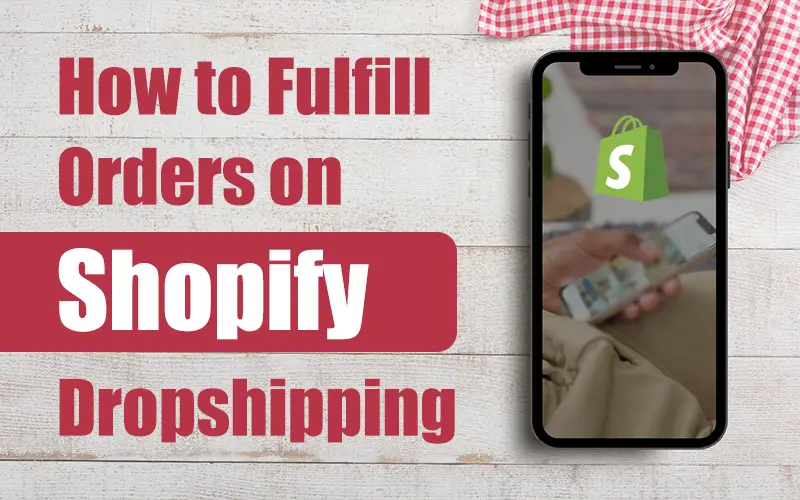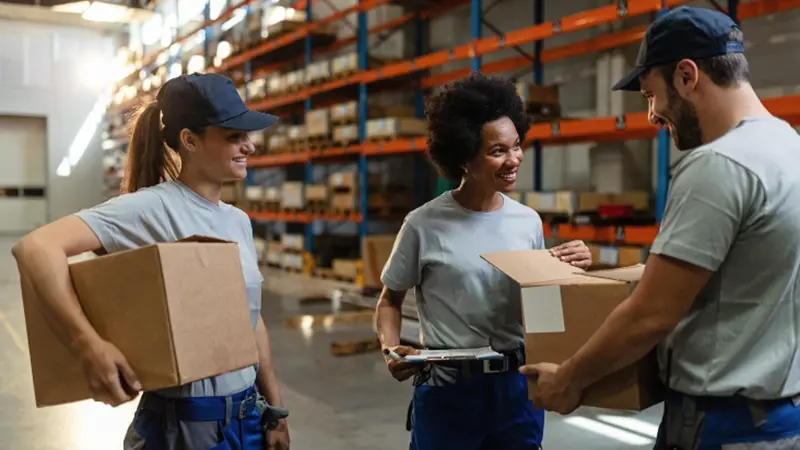Sind Sie bereit, einen gut funktionierenden Shopify-Dropshipping-Shop zu erstellen? Zu Beginn müssen Sie eine Menge beachten. Aber letztendlich läuft der Gewinn darauf hinaus, zu verstehen, wie Sie Bestellungen über Shopify-Dropshipping abwickeln. Fachwissen in der Auftragsabwicklung kann den Unterschied zwischen zufriedenen Kunden und verpassten Gelegenheiten ausmachen.
In diesem umfassenden Leitfaden führen wir Sie durch alle Einzelheiten der Auftragsabwicklung und der Automatisierung Ihres Auftragsabwicklungs-Workflows. Es ist an der Zeit, sich von manuellen Fehlern zu verabschieden und eine effiziente Auftragsabwicklung zu begrüßen, die Ihre Kunden immer wieder zu Ihnen zurückbringt.

Seitenübersicht:
Was ist Dropshipping-Fulfillment?
Vorteile der Dropshipping-Erfüllung
Wie erfüllt man Dropshipping-Bestellungen auf Shopify?
Schritt 1: Verbinden Sie Ihren Shopify-Shop mit einem Dropshipping-Lieferanten
Schritt 2: Produkte in Ihren Shopify-Shop importieren
Schritt 3: Der Kunde gibt eine Bestellung auf
Schritt 4: Bestellung automatisch mit Ihrem Lieferanten synchronisieren
Schritt 5: Teilen Sie Ihrem Lieferanten die Bestelldetails mit
Schritt 6: Der Lieferant verpackt und versendet die Produkte an Ihren Kunden
EPROLO: Automatisiertes Auftragsabwicklungstool für Shopify Dropshipping
So erfüllen Sie Dropshipping-Bestellungen bei Shopify – Fazit
Was ist Dropshipping-Fulfillment?
Moderne Ordnung Fulfillment hat die traditionelle Methode der Bestandsverwaltung verändert.
Und so funktioniert es: Wenn ein Kunde eine Bestellung aufgibt, leitet das Unternehmen (oder der Verkäufer) die Bestelldetails an einen Drittanbieter weiter. Der Lieferant kümmert sich um die Verpackung und versendet das Produkt direkt an den Kunden.
Anstatt also Lagerbestände aufzubewahren und Lagervorgänge durchzuführen, kann sich das Unternehmen auf andere Aspekte wie Marketing und Kundenbeziehungen konzentrieren.
An der Dropshipping-Abwicklung beteiligte Parteien
1. Hersteller
Die Dropshipping-Lieferkette beginnt beim Hersteller. Sie stellen die Produkte in großen Mengen her, verkaufen sie aber normalerweise nicht direkt an Kunden.
Sie produzieren für den Verkauf an Lieferanten und Großhändler. Diese Unternehmen investieren Ressourcen – von Ausrüstung, Rohstoffen bis hin zu Arbeitskräften –, um Produkte in großem Maßstab herzustellen.
2. Dropshipping-Lieferanten
Diese Zwischenhändler fungieren als zentrales Bindeglied zwischen Herstellern und Einzelhändlern. Sie stehen mit mehreren Herstellern in Kontakt und führen Lagerbestände.
Auf der anderen Seite kümmern sie sich um die Logistik rund um die Auftragserfüllung für die Einzelhändler. Oftmals erweitern Dropshipping-Lieferanten ihr Angebot um zusätzliche Dienstleistungen, wie Produktfotografie und Bestandsverwaltungssysteme, um Einzelhändler zu unterstützen.

3. Einzelhändler (Dropshipper)
Einzelhändler, Dropshipper und Verkäufer sind einige Bezeichnungen für Unternehmer, die in ihrem Online-Shop Produkte ohne Lagerhaltung verkaufen.
Wenn ein Kunde eine Bestellung im Geschäft aufgibt, kaufen Dropshipper Produkte von einem Dropshipping-Lieferant (der es vom Hersteller bezieht), um die Bestellung auszuführen.
Zu den Hauptaufgaben eines Einzelhändlers gehören Marketing, Kundenservice und die Einrichtung eines attraktiven Online-Shops.
Vorteile der Dropshipping-Erfüllung
Bevor wir besprechen, wie Sie Dropshipping-Bestellungen auf Shopify ausführen, schauen wir uns zunächst an, warum Sie Folgendes in Betracht ziehen sollten Shopify Dropshipping-Erfüllung. Nachfolgend finden Sie die wichtigsten Vorteile der Dropshipping-Erfüllung.
1. Einfach ein Unternehmen gründen
Einer der wichtigsten Gründe für die Wahl von Dropshipping-Fulfillment sind die sehr niedrigen Einstiegshürden. Im Gegensatz zu traditionellen Einzelhandelsmodellen sind für den Start keine großen Kapitalinvestitionen erforderlich.
Sie müssen den Lagerbestand nicht im Voraus bezahlen, Sie müssen keine Lagerfläche mieten oder Tausende für die Logistikinfrastruktur ausgeben.
Alles, was Sie brauchen, ist ein Computer, eine Internetverbindung und eine gut gestaltete E-Commerce-Website. Dank dieser Zugänglichkeit können aufstrebende Unternehmer mit geringem finanziellen Risiko und hohem Verdienstpotenzial immer einen Schritt voraus sein.
2. Vielfältige Produktoptionen
Dropshipping eröffnet eine Welt voller Möglichkeiten hinsichtlich der Produkte, die Sie anbieten können. Da Sie nicht auf physische Lagerbestände beschränkt sind, können Sie mit vielfältige Produkte.
Darüber hinaus ist es eine ideale Möglichkeit, neue Produktlinien als Reaktion auf Markttrends zu testen. Gleichzeitig können Sie Ihr Angebot an die Kundennachfrage anpassen.
Es gibt Ihnen die Freiheit, auszuprobieren neue Nischen und Produktklassifizierungen. Sie können experimentieren, bis Sie die Kombination finden, die für Ihren gewählten Markt am besten funktioniert.

3. Standortunabhängigkeit
Dropshipping ist ortsunabhängig. Sie können Ihr Geschäft betreiben, solange Sie Internetzugang haben. Unternehmer können von überall aus tätig sein, ohne den Zwängen des traditionellen Lebensstils ausgesetzt zu sein.
Außerdem müssen Sie nicht physisch anwesend sein, um Inventar oder Versand abzuwickeln. Das macht es zu einem großartigen Geschäftsmodell für den digitalen Nomaden oder diejenigen, die Wert auf Flexibilität legen.
4. Reduziertes Risiko
Im Vergleich zur brutalen Realität des traditionellen Einzelhandels minimiert Dropshipping die finanziellen Risiken auf einen Bruchteil. Da Sie Produkte erst kaufen, nachdem Sie Bestellungen von Kunden erhalten haben, können Sie tote Lagerbestände oder veraltete Lagerbestände vermeiden.
Das Modell macht Großeinkäufe überflüssig und verringert die Wahrscheinlichkeit, dass Sie zu viele Lagerbestände haben. Schließlich müssen Sie sich nicht mit Lagerkosten und Lagerschäden herumschlagen, denn dafür sind Ihre Lieferanten verantwortlich.
5. Flexibles Wachstum
Die Skalierbarkeit von Dropshipping ist unbegrenzt. Wenn Ihr Unternehmen wächst, müssen Sie sich keine Gedanken über die Suche nach mehr Lagerraum oder die Einstellung neuer Mitarbeiter zur Bestandsverwaltung machen.
Außerdem sind Sie nicht länger an Ihren aktuellen Geschäftsstatus gebunden. Sie können Ihre Produktlinien erweitern, neue Märkte erschließen oder Kosten senken, ohne dass kostspielige Betriebsänderungen erforderlich sind.
Wie erfüllt man Dropshipping-Bestellungen auf Shopify?
Jetzt, da Sie die Vorteile der Dropshipping-Fulfillment-Modell besteht der nächste Schritt darin, zu lernen, wie Dropshipping-Bestellungen auf Shopify erfüllt werden.
Schritt 1: Verbinden Sie Ihren Shopify-Shop mit einem Dropshipping-Lieferanten
Der erste entscheidende Schritt besteht darin, eine Verbindung herzustellen zwischen Ihrem Shopify-Shop und ein zuverlässiger Lieferant. Dies kann auf verschiedene Arten erfolgen:
- Installieren Sie eine Dropshipping-App aus dem Shopify App Store. Stellen Sie sicher, dass sie mit dem von Ihnen gewählten Lieferanten integriert ist.
- Nutzen Sie beliebte Plattformen wie EPROLO.
- Bietet Ihr Lieferant die Möglichkeit, eine direkte API Verbindung, sollten Sie es tun.
Denken Sie daran, vor der Integration Nachforschungen über Ihre Lieferanten anzustellen. Ihr Geschäftserfolg hängt von einer guten Lieferantenbeziehung ab.
Schritt 2: Produkte in Ihren Shopify-Shop importieren
Sobald Sie mit einem Lieferanten verbunden sind, besteht der nächste Schritt darin, Ihren Shop mit Produkten zu füllen:
- Durchsuchen Sie Lieferantenkataloge mit der von Ihnen gewählten Dropshipping-Plattform.
- Wählen Sie im Geschäft Produkte aus, die zu Ihrer Nische und Ihrem Zielmarkt passen.
- Produktdetails importieren (Beschreibungen, Bilder und Varianten).
- Sie können die Produktinformationen auch an die Stimme Ihrer Marke anpassen.
- Legen Sie angemessene Preise fest, um gute Gewinnspannen zu erzielen. Nehmen Sie sich Zeit, um die Produktlisten zu optimieren.
Schritt 3: Der Kunde gibt eine Bestellung auf
Wenn ein Kunde ein Produkt in Ihrem Shopify-Shop kauft, wird die Bestellung automatisch in Ihrem Shopify-Konto erfasst. Die Zahlung erfolgt dann über das Zahlungsgateway.
Im Falle einer Bestellung wird dem Kunden eine Bestellbestätigungs-E-Mail zugesandt. Ihr Dashboard wird mit dem Status der Bestellung auf „Nicht ausgeführt“ aktualisiert. Der Ausführungsprozess beginnt dann und gewährleistet Ihrem Kunden ein einfaches Einkaufserlebnis.
Schritt 4: Bestellung automatisch mit Ihrem Lieferanten synchronisieren
Moderne Dropshipping-Plattformen bieten automatisierte Auftragssynchronisierung. Aufträge werden automatisch an das System Ihres Lieferanten weitergeleitet. Dieser Service optimiert die Auftragsabwicklung auf Shopify dropshipping.
Die Produktverfügbarkeit wird in Echtzeit überprüft und die Versandkosten berechnet. Abschließend werden die Bestelldetails auf ihre Richtigkeit überprüft. Diese Automatisierung minimiert manuelle Arbeit und Fehler bei der Auftragsabwicklung.
Schritt 5: Teilen Sie Ihrem Lieferanten die Bestelldetails mit
Für eine reibungslose Auftragsabwicklung ist eine klare Kommunikation mit Ihrem Lieferanten unerlässlich:
- Stellen Sie sicher, dass alle Bestelldetails, einschließlich Produktspezifikationen, Kundenpräferenzen, Lieferadresse usw., korrekt übermittelt werden.
- Bestätigen Sie den Bestelleingang bei Ihrem Lieferanten.
- Erhalten Sie Tracking-Informationen, sobald die Bestellung bearbeitet wurde.
- Richten Sie automatische Benachrichtigungen für Aktualisierungen des Bestellstatus ein. Durch die Aufrechterhaltung offener Kommunikationskanäle können Probleme bei der Auftragserfüllung vermieden und eine schnelle Problemlösung ermöglicht werden.

Schritt 6: Der Lieferant verpackt und versendet die Produkte an Ihren Kunden
Die letzte Phase des Erfüllungsprozesses besteht darin, dass der Lieferant die bestellten Artikel zusammenstellt und die Produkte verpackt. Mit der Adresse eines Kunden erstellt er Versandetiketten. Damit können Sie Tracking-Informationen in Ihren Shopify-Shop hochladen und automatisierte Benachrichtigungen an Kunden senden.
In dieser Phase ist es wichtig, den Bestellstatus regelmäßig zu überprüfen und Ihre Kunden über den Bestellvorgang auf dem Laufenden zu halten. Sie müssen auch schnell auf Lieferverzögerungen oder -probleme reagieren.
Ein gut ausgeführter Auftragserfüllungsprozess beschert Ihnen zufriedene Kunden und Folgeaufträge. Wenn Sie klare Kommunikationskanäle sowohl mit Ihren Lieferanten als auch mit Ihren Kunden haben, können Sie vermeiden, im Chaos gefangen zu sein.
EPROLO: Automatisiertes Auftragsabwicklungstool für Shopify Dropshipping
Wenn es um die Abwicklung von Dropshipping-Bestellungen über Shopify geht, ist Ihr Dropshipping-Partner von großer Bedeutung.
EPROLO ist eine All-in-One-Plattform mit leistungsstarken Automatisierungstools. Sie bietet außerdem robuste Produktbeschaffungsfunktionen und ist damit perfekt für beide Anfänger und erfahrene Dropshipper.
Schauen wir uns einige der Funktionen und Vorteile von EPROLO an, die es zu einem bahnbrechenden Neuer im Dropshipping-Geschäft machen.

Kostengünstige Lösungen
Mit der wettbewerbsfähigen Preisstruktur von EPROLO können Sie Ihre Rentabilität maximieren. Die Plattform ist völlig kostenlos und enthält keine versteckten Kosten. Sie erhalten Großhandelspreise vom Hersteller. So können Sie Ihre Betriebskosten niedrig halten und gleichzeitig gesunde Gewinne erzielen.
Darüber hinaus besteht bei wachsendem Unternehmen die Möglichkeit, die Kosten zu senken und bei Großbestellungen Mengenrabatte zu erhalten.
Umfangreiches Produktangebot
Entdecken Sie die neueste Trendartikel aus vielen Nischen mit dem Marktplatz von EPROLO. Das Produktforschungsteam aktualisiert den Katalog kontinuierlich mit Artikeln mit hohem Potenzial und spart Ihnen so wertvolle Zeit bei der Produktbeschaffung.
Sie erhalten detaillierte Spezifikationen, qualitativ hochwertige Bilder und wettbewerbsfähige Preise für jedes Produkt. So können Sie eine fundierte Entscheidung über den Lagerbestand Ihres Ladens treffen.
Nahtlose Shopify-Integration
Die Ein-Klick-Integration von EPROLO mit Shopify sorgt für einen reibungslosen Einrichtungsprozess. Die Plattform synchronisiert sich perfekt mit Ihrem Shopify-Shop und ermöglicht automatische Updates von Lagerbeständen, Preisen und Bestellstatus.
Diese nahtlose Verbindung macht die manuelle Dateneingabe überflüssig und reduziert Fehler in Ihren Betriebsabläufen.
Automatisierungsfunktionen
| Dropshipping-Produktimport | Dropshipping-Preisfestlegung | Dropshipping-Auftragsabwicklung | Dropshipping-Lieferverfolgung |
|---|---|---|---|
| Massenimportfunktionen für mehrere Produkte | Automatisierte Preisregeln basierend auf Ihren Gewinnspannen | Automatische Bestellsynchronisierung von Shopify | Aktualisierungen der Tracking-Informationen in Echtzeit |
| Nahtlose Importfunktion der EPROLO Chrome-Erweiterung | Funktionen zur Massenpreisanpassung | Intelligente Auftragsweiterleitung an optimale Lieferanten | Automatisiertes Kundenbenachrichtigungssystem |
| Kategoriebasierter Import für eine organisierte Filialverwaltung | Dynamisch Preisstrategien für verschiedene Märkte | Möglichkeiten zur Verarbeitung von Massenbestellungen | Zentralisiertes Tracking-Management-Dashboard |
Bestandsverwaltung in Echtzeit
Behalten Sie mit dem Echtzeit-Lagerverfolgungssystem von EPROLO die Übersicht über Ihre Produktverfügbarkeit.
Die Plattform synchronisiert automatisch die Lagerbestände in Ihrem Geschäft und Ihrem Lieferantennetzwerk. Dies verhindert Überverkäufe und stellt die Kundenzufriedenheit sicher.
Erhalten Sie sofortige Benachrichtigungen bei Lagerbeständen von Artikeln mit niedrigem Lagerbestand und automatische Nachbestellfunktionen.
Kundenspezifischer Branding-Service
EPROLO's Private-Label-Lösungen helfen Ihnen beim Aufbau Ihrer Markenidentität. Die Plattform bietet umfassende Branding-Lösungen, vom Echtzeit-Design bis hin zu maßgeschneiderter Verpackung, damit sich Ihr Unternehmen von der Masse abhebt.
Damit sorgen Sie mit maßgeschneiderten Verpackungsmaterialien und Beilagen für ein professionelles und einheitliches Markenerlebnis bei Ihren Kunden.

Globale Lager
Nutzen Sie das Netzwerk strategischer Lagerhäuser von EPROLO auf der ganzen Welt, um Versandzeit und -kosten zu reduzieren. Durch den Betrieb mehrerer Fulfillment-Zentren auf verschiedenen Kontinenten können Sie Ihre Kunden schneller beliefern.
EPROLO's Globale Lager senken die Versandkosten und verbessern die Kundenzufriedenheit vor Ort durch schnellere Lieferzeiten.
Exzellenter Kundensupport
Sie haben Zugriff auf mehrere Supportkanäle, darunter Live-Chat, Telefon-Support und E-Mail-Support.
EPROLO bietet ein rund um die Uhr verfügbares Kundenserviceteam. Es kann Ihnen bei der Lösung aller Probleme helfen und alle Ihre Fragen beantworten. Es gibt auch jede Menge Dokumentation und Ressourcen, damit Sie die Funktionen der Plattform nutzen können.
So erfüllen Sie Dropshipping-Bestellungen bei Shopify – Fazit
Zu wissen, wie Dropshipping-Bestellungen bei Shopify abgewickelt werden, ist der Schlüssel zu einem erfolgreichen Geschäft. Mit den richtigen Tools und Prozessen ist das kein Problem. Sie können ganz einfach ein optimiertes Fulfillment-System erstellen. So bleiben Ihre Kunden zufrieden und Ihr Geschäft wächst.
Es geht immer darum, automatisiert und zuverlässig zu sein und den Kunden zufriedenzustellen. Indem Sie die richtigen Lieferanten auswählen und die Schritte und Best Practices befolgen, sind Sie bereit, Bestellungen effizient abzuwickeln. Mit diesen Strategien können Sie Ihr Dropshipping-Geschäft im Handumdrehen skalieren.
FAQs
Worin unterscheiden sich Dropshipping-Bestellungen von regulären Bestellungen?
Der Hauptunterschied besteht in der Bestandsverwaltung. Bei regulären Bestellungen holen Sie die zu verkaufenden Produkte ab und lagern sie, bevor Sie sie direkt an Ihre Kunden versenden.
Beim Dropshipping kümmern Sie sich nicht um die Bestandsverwaltung; das übernimmt Ihr Lieferant und schickt die Ware direkt an Ihre Kunden. Dadurch wird kein Lagerraum benötigt und Sie sparen Vorlaufkosten.
Muss ich Bestellungen bei Shopify manuell ausführen?
Sie müssen Bestellungen nicht manuell ausführen. Mit Dropshipping-Apps und Automatisierungstools können Sie die Auftragsabwicklung automatisch durchführen.
Sie leiten Bestellungen für Sie automatisch an Ihre Lieferanten weiter und aktualisieren die Tracking-Informationen, sodass Sie nicht viel Zeit aufwenden müssen.
Was ist der ideale Weg, um Shopify-Dropshipping-Bestellungen abzuschließen?
Die beste Methode zur Abwicklung von Shopify-Dropshipping-Bestellungen ist die automatisierte Auftragsabwicklung. Diese Methode lässt sich direkt in Ihren Shop integrieren.
Mithilfe der Dropshipping-Plattformen können Sie Kontakte zu zuverlässigen Lieferanten knüpfen, Auftragsabwicklungssysteme automatisieren und eine Bestandsverfolgung in Echtzeit ermöglichen.
Bei diesem automatisierten Ansatz werden manuelle Eingriffe minimiert und die Konsistenz Ihres Auftragserfüllungsprozesses sichergestellt.







